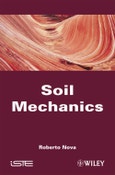Table of Contents
Preface.Chapter 1 Introduction: Basic Concepts.
1.1 Soils and rocks.
1.2 Engineering properties of soils.
1.3 Soils as an aggregation of particles.
1.4 Interaction with pore water.
1.5 Transmission of the stress state in granular soil.
1.6 Transmission of the stress state in the presence of a fluid.
1.7 From discrete to continuum.
1.8 Stress and strain tensors.
1.9 Bibliography.
Chapter 2 Field Equations for a Porous Medium.
2.1 Equilibrium equations.
2.2 Compatibility equations.
2.3 Constitutive laws.
2.4 Geostatic stress state and over–consolidation.
2.5 Continuity equation and Darcy′s law.
2.6 Particular cases.
2.6.1 Dry soil.
2.6.2 Saturated soil with still groundwater.
2.6.3 Saturated soil with seepage: stationary conditions.
2.6.4 Saturated soil with seepage: transient conditions.
2.7 Bibliography.
Chapter 3 Seepage: Stationary Conditions.
3.1 Introduction.
3.2 The finite difference method.
3.3 Flow net.
3.4 Excess pore pressure.
3.5 Instability due to piping.
3.6 Safety factor against piping.
3.7 Anisotropic permeability.
3.8 Transition between soils characterized by different permeability coefficient.
3.9 Free surface problems.
3.10 In situ methods for the permeability coefficient determination.
3.11 Bibliography.
Chapter 4 Seepage: Transient Conditions.
4.1 One–dimensional consolidation equation.
4.2 Excess pore pressure isochrones.
4.3 Consolidation settlement.
4.4 Consolidation settlement: approximated solution.
4.5 Consolidation under different initial or boundary conditions.
4.6 Load linearly increasing over time: under consolidation.
4.7 Consolidation under axial sysmmetric conditions.
4.8 Multidimensional consolidation: the Mandel–Cryer effect.
4.9 Oedometer test and measure of cv.
4.10 Influence of the skeleton viscosity.
4.11 Bibliography.
Chapter 5 The Constitutive Relationship: Tests and Experimental Results.
5.1 Introduction.
5.2 Fundamental requirements of testing apparatus.
5.3 Principal testing apparatus.
5.3.1 The "true" triaxial test (TTA): Lame′s ellipsoid and Mohr′s sickle.
5.3.2 The (standard) triaxial apparatus.
5.3.3 The oedometer.
5.3.4 The biaxial apparatus.
5.3.5 Direct shear box and simple shear apparatus (SSA).
5.3.6 Hollow cylinder.
5.4 The stress path concept.
5.5 Experimental results for isotropic tests on virgin soils.
5.6 Experimental results for radial tests on virgin soils: stress, dilatancy relationship.
5.7 Oedometric tests on virgin soil as a particular case of the radial test: earth pressure coefficient at rest.
5.8 Drained triaxial tests on loose sands: Mohr–Coulomb failure criterion.
5.9 Undrained triaxial tests on loose sands: instability line and static liquefaction.
5.10 Drained tests on dense and medium dense sand: dilatancy and critical state.
5.11 Strain localization: shear band formation.
5.12 Undrained tests on dense and medium dense sands: phase transformation line.
5.13 Sand behavior in tests in which the three principal stresses are independently controled: failure in the deviatoric plane.
5.14 Normally consolidated and over–consolidated clays: oedometric tests with loading unloading cycles––extension failure.
5.15 Drained and undrained triaxial tests on normally consolidated clays: normalization of the mechanical behavior.
5.16 Over–consolidated clays.
5.17 The critical state. Plasticity index.
5.18 Natural soils: apparent over–consolidation––yielding surface.
5.19 Soil behavior under cyclic loading: cyclic mobility and strength degradation.
5.20 Bibliography.
Chapter 6 The Constitutive Relationship: Mathematical Modeling of the Experimental behavior.
6.1 Introduction.
6.2 Nonliner elasticity.
6.3 Perfect elastic–plasticity.
6.4 Yielding of metals.
6.5 Taylor and Quinney experiments: the normality postulate.
6.6 Generalized variables of stress and strain.
6.7 Plastic strains for a material behaving as described by the Mohr–Coulomb criterion.
6.8 Drucker–Prager and Matsuoka–Nakai failure Criteria.
6.9 Dilatancy: non–associated flow rule.
6.10 Formulation of an elastic–perfectly plastic law.
6.11 Cam clay model.
6.12 Reformulation of the Cam clay model as an elastic–plastic hardening model.
6.13 Comparison between experimental behavior and mathematical modeling for normally consolidated clays.
6.14 Lightly over–Consolidated clays.
6.15 Heavily over–consolidated clays.
6.16 Subsequent developments and applications.
6.17 Non–associated flow rule: the Nova–Wood model.
6.18 Sinfonietta classica: a model for soils and soft rocks.
6.19 Models for soils subjected to cyclic loading.
6.20 Conceptual use of constitutive soil behavior models.
6.20.1 Oedometric test.
6.20.2 Unconfined undrained (UU) test.
6.20.3 Shear modulus "anisotropy."
6.21 Bibliography.
Chapter 7 Numerical solution to Boundary Value Problems.
7.1 Introduction.
7.2 The finite element method for plane strain problems.
7.3 Earth pressures on retaining structures.
7.4 Settlements and bearing capacity of shallow foundations.
7.5 Numerical solution of boundary value problems for fully saturated soil.
7.6 Undrained conditions: short–term bearing capacity of a footing.
7.7 Short–and long–term stability of an excavation.
7.8 Bibliography.
Postscript.
Index.








